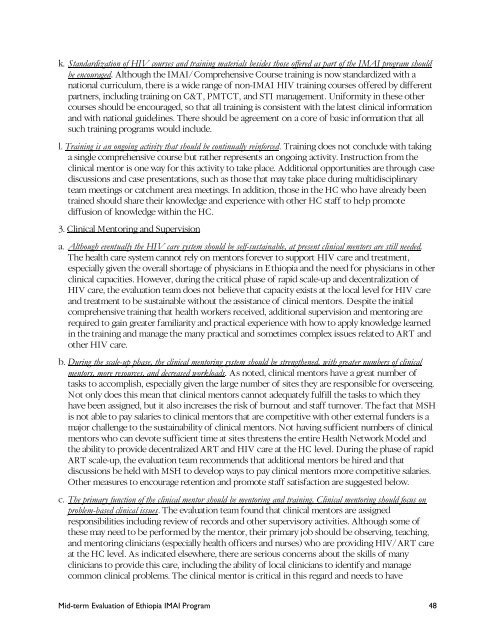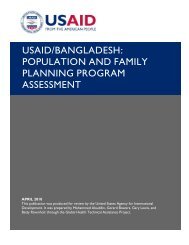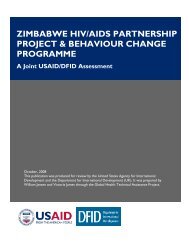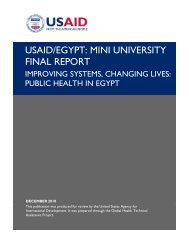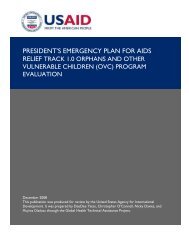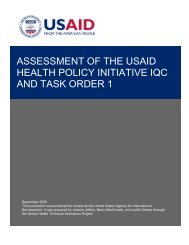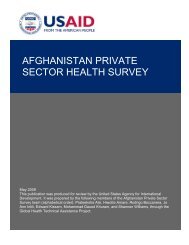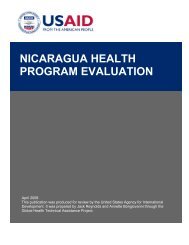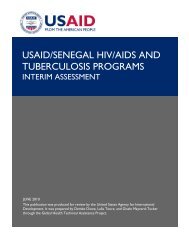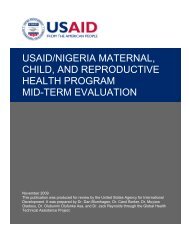usaid/ethiopia pepfar mid-term evaluation of the ... - GH Tech
usaid/ethiopia pepfar mid-term evaluation of the ... - GH Tech
usaid/ethiopia pepfar mid-term evaluation of the ... - GH Tech
- No tags were found...
You also want an ePaper? Increase the reach of your titles
YUMPU automatically turns print PDFs into web optimized ePapers that Google loves.
k. Standardization <strong>of</strong> HIV courses and training materials besides those <strong>of</strong>fered as part <strong>of</strong> <strong>the</strong> IMAI program shouldbe encouraged. Although <strong>the</strong> IMAI/Comprehensive Course training is now standardized with anational curriculum, <strong>the</strong>re is a wide range <strong>of</strong> non-IMAI HIV training courses <strong>of</strong>fered by differentpartners, including training on C&T, PMTCT, and STI management. Uniformity in <strong>the</strong>se o<strong>the</strong>rcourses should be encouraged, so that all training is consistent with <strong>the</strong> latest clinical informationand with national guidelines. There should be agreement on a core <strong>of</strong> basic information that allsuch training programs would include.l. Training is an ongoing activity that should be continually reinforced. Training does not conclude with takinga single comprehensive course but ra<strong>the</strong>r represents an ongoing activity. Instruction from <strong>the</strong>clinical mentor is one way for this activity to take place. Additional opportunities are through casediscussions and case presentations, such as those that may take place during multidisciplinaryteam meetings or catchment area meetings. In addition, those in <strong>the</strong> HC who have already beentrained should share <strong>the</strong>ir knowledge and experience with o<strong>the</strong>r HC staff to help promotediffusion <strong>of</strong> knowledge within <strong>the</strong> HC.3. Clinical Mentoring and Supervisiona. Although eventually <strong>the</strong> HIV care system should be self-sustainable, at present clinical mentors are still needed.The health care system cannot rely on mentors forever to support HIV care and treatment,especially given <strong>the</strong> overall shortage <strong>of</strong> physicians in E thiopia and <strong>the</strong> need for physicians in o<strong>the</strong>rclinical capacities. However, during <strong>the</strong> critical phase <strong>of</strong> rapid scale-up and decentralization <strong>of</strong>HIV care, <strong>the</strong> <strong>evaluation</strong> team does not believe that capacity exists at <strong>the</strong> local level for HIV careand treatment to be sustainable without <strong>the</strong> assistance <strong>of</strong> clinical mentors. Despite <strong>the</strong> initialcomprehensive training that health workers received, additional supervision and mentoring arerequired to gain greater familiarity and practical experience with how to apply knowledge learnedin <strong>the</strong> training and manage <strong>the</strong> many practical and sometimes complex issues related to ART ando<strong>the</strong>r HIV care.b. During <strong>the</strong> scale-up phase, <strong>the</strong> clinical mentoring system should be streng<strong>the</strong>ned, with greater numbers <strong>of</strong> clinicalmentors, more resources, and decreased workloads. As noted, clinical mentors have a great number <strong>of</strong>tasks to accomplish, especially given <strong>the</strong> large number <strong>of</strong> sites <strong>the</strong>y are responsible for overseeing.Not only does this mean that clinical mentors cannot adequately fulfill <strong>the</strong> tasks to which <strong>the</strong>yhave been assigned, but it also increases <strong>the</strong> risk <strong>of</strong> burnout and staff turnover. The fact that MSHis not able to pay salaries to clinical mentors that are competitive with o<strong>the</strong>r external funders is amajor challenge to <strong>the</strong> sustainability <strong>of</strong> clinical mentors. Not having sufficient numbers <strong>of</strong> clinicalmentors who can devote sufficient time at sites threatens <strong>the</strong> entire Health Network Model and<strong>the</strong> ability to provide decentralized ART and HIV care at <strong>the</strong> HC level. During <strong>the</strong> phase <strong>of</strong> rapidART scale-up, <strong>the</strong> <strong>evaluation</strong> team recommends that additional mentors be hired and thatdiscussions be held with MSH to develop ways to pay clinical mentors more competitive salaries.O<strong>the</strong>r measures to encourage retention and promote staff satisfaction are suggested below.c. The primary function <strong>of</strong> <strong>the</strong> clinical mentor should be mentoring and training. Clinical mentoring should focus onproblem-based clinical issues. The <strong>evaluation</strong> team found that clinical mentors are assignedresponsibilities including review <strong>of</strong> records and o<strong>the</strong>r supervisory activities. Although some <strong>of</strong><strong>the</strong>se may need to be performed by <strong>the</strong> mentor, <strong>the</strong>ir primary job should be observing, teaching,and mentoring clinicians (especially health <strong>of</strong>ficers and nurses) who are providing HIV/ ART careat <strong>the</strong> HC level. As indicated elsewhere, <strong>the</strong>re are serious concerns about <strong>the</strong> skills <strong>of</strong> manyclinicians to provide this care, including <strong>the</strong> ability <strong>of</strong> local clinicians to identify and managecommon clinical problems. The clinical mentor is critical in this regard and needs to haveMid-<strong>term</strong> Evaluation <strong>of</strong> Ethiopia IMAI Program 48


